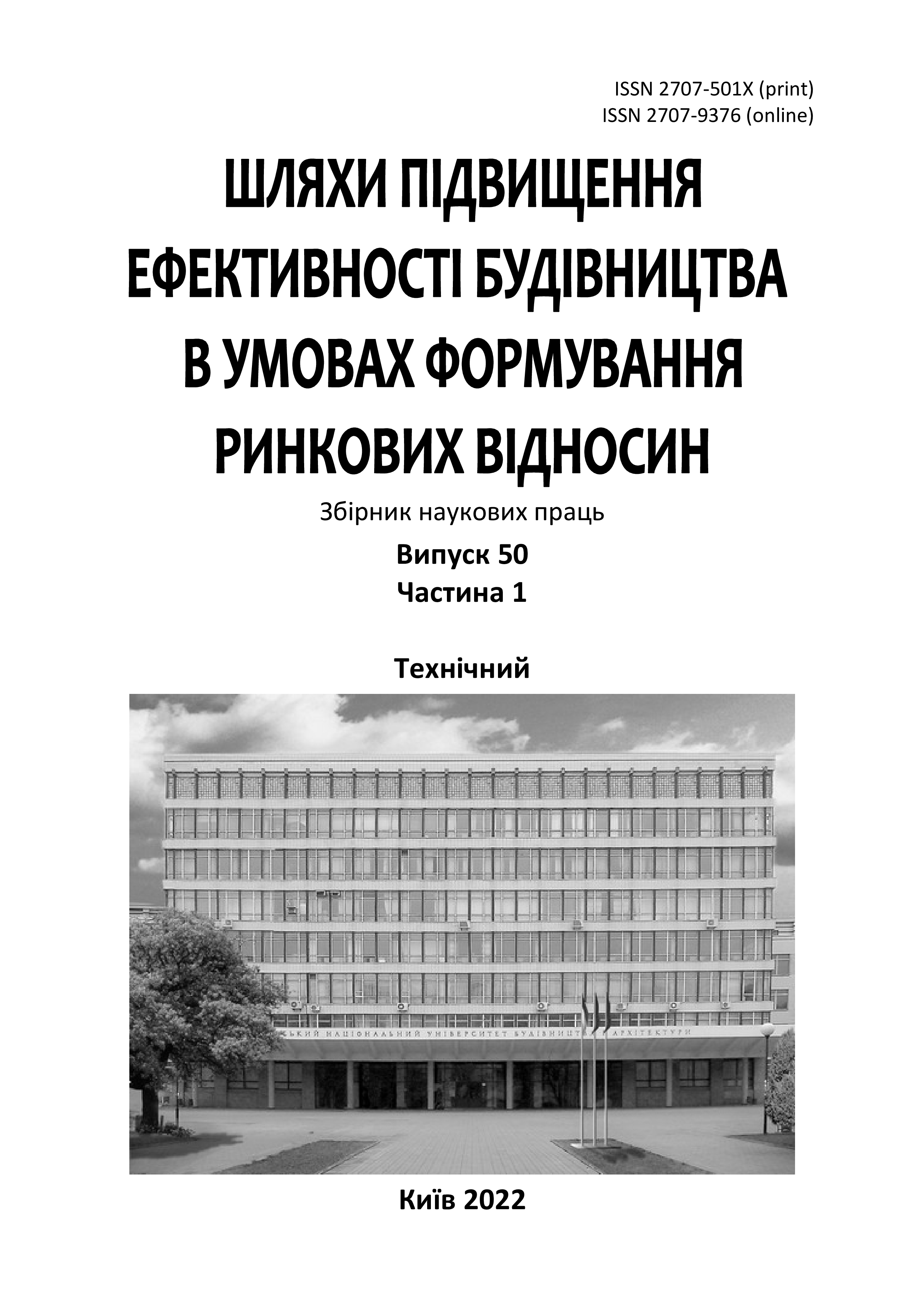Experimental research of technological properties of concrete mixing compression process under reconstruction conditions
DOI:
https://doi.org/10.32347/2707-501x.2022.50(1).3-14Keywords:
experimental researches of a condition of building designs, the equipment of digital information processing, reconstruction, monitoring of a technical conditionAbstract
The article is devoted to the experimental determination of technological properties of concrete mixtures in the conditions of reconstruction of buildings and structures. The technology of construction works under erection and reconstruction largely depends on the properties of the main building materials, the peculiarities of the environment and also on the technological processes. Today, monolithic–frame construction technology is quite common, so the condition of high–quality performance of works is to determine and effectively use the properties of the concrete mixture, taking into account the methods and modes of technological processes. The relevance of doing inspections of buildings and structures in order to assess their technical condition, both in terms of operation and in terms of reconstruction or modernization was also emphasized. The purpose of work was development of a method of definition of properties of building structure during reconstruction of buildings and constructions and also algorithm of selection of a set of the experimental equipment was established. The analysis of modern methods for determining the properties of building materials and structures and analog–digital information processing devices to establish a real physical picture of changes in the stress–strain state of building structures in terms of reconstruction has been done. The method of determining the main properties of building structures using the theory of planning experiments was given. The scheme of installation of sensors and algorithm of data recording and processing of research results were given. Recommendations of using the main types of sensors and recording equipment to determine the stresses and strains that occur in building structures under operating conditions were given. Recommendations for the creation of research complexes in accordance to objectives and technological requirements were given. The main characteristics of monitoring the technical condition of building structures for the assessment and prediction of deformation processes in real time in order to minimize deviations of system parameters from operational values have been determined.
References
Адлер Ю.П., Маркова Е.В., Грановский Ю.В. Планирование эксперимента при поиске оптимальных условий. М.: Наука, 1976. 279 с.
Басараб В.А. Дослідження полічастотного режиму коливань робочого органу електромагнітної ударно–вібраційної установки. Управління розвитком складних систем, № 34. 2018. С. 182 – 187.
Басараб В.А. Використання вимірювальної апаратури для дослідження фізичних процесів системи “машина–середовище”. Теорія і практика будівництва, №11. 2013. С. 26–30.
ДСТУ Б В.2.7–176:2008 Суміші бетонні та бетон. Загальні технічні умови. [Чинний від 30.09.2009]. Київ: Мінрегіонбуд України, 2010. 109 с.
ДСТУ Б В.2.7–214:2009 Бетони. Методи визначення міцності за контрольними зразками. [Чинний від 22.12.2009]. Київ: Мінрегіонбуд України, 2010. 43 с.
Корн Г., Корн Т. Справочник по математике для инженеров и научных работников. М.: Наука, 1984. 832 с.
Осипов А.Ф. Основные принципы проектирования динамически трансформирующихся технологических систем. Прикладна геометрія та інженерна графіка, Вип.67. 2000. С. 162 – 165.
Тонкачеєв Г.М., Осипов О.Ф., Черненко В.К. Проектування технології зведення спеціальних будівель і споруд: методичні вказівки. К.: КНУБА, 2010. 48 с.
Радіотехніка: Енциклопедичний навчальний довідник: Навч. посіб. / За ред. Ю.Л. Мазора, Є.А. Мачуського, В.І. Правди. К.: Вища школа, 1999. 838 с.
Технологія будівельного виробництва: підручник / М.Г. Ярмоленко, Є.Г. Романушко, В.І. Терновий та ін. К.: Вища шк., 2005. 342 с.
Downloads
Published
How to Cite
Issue
Section
License

This work is licensed under a Creative Commons Attribution 4.0 International License.
Authors who publish with this journal agree to the following terms:
- Authors retain copyright and grant the journal right of first publication with the work simultaneously licensed under a Creative Commons Attribution License that allows others to share the work with an acknowledgement of the work's authorship and initial publication in this journal.
- Authors are able to enter into separate, additional contractual arrangements for the non-exclusive distribution of the journal's published version of the work (e.g., post it to an institutional repository or publish it in a book), with an acknowledgement of its initial publication in this journal.
- Authors are permitted and encouraged to post their work online (e.g., in institutional repositories or on their website) prior to and during the submission process, as it can lead to productive exchanges, as well as earlier and greater citation of published work (See The Effect of Open Access).

